Indirect Electrostatic Discharge (ESD) Effects on Shielded Components Installed in MV/LV Substations
Abstract
:1. Introduction
- (i)
- the proposal of a new analytical expression for the ESD current waveform, stemming from measured data available in the literature and proved to be more severe than those proposed by the standards;
- (ii)
- the analysis of two actual shielding enclosures with physical dimensions smaller than the minimum value considered in the relevant standards, considering all the constructive details;
- (iii)
- the general conclusion that the interference levels due to an indirect ESD may be of the same order of magnitude as the functioning signals at the specific positions where the critical devices are installed inside typical small enclosures.
2. Literature Overview on the Shielding Effectiveness of Small Enclosures and ESD Electromagnetic Interference Characteristics
2.1. Electrostatic Discharge Characterization
- IEC 60749-26—HBM. The human body model simulates a person becoming charged and discharging through the circuit under test. Humans are a source of ESD.
- IEC 60749-27—MM. The machine model simulates a machine or metal tool discharging through a device to ground. (This standard has been discontinued). It does not offer any additional information to that of the HBM and the charged device model (CDM) below.
- IEC 60749-28—CDM. The charged device model simulates an integrated circuit becoming charged and discharging to a grounded metal surface.
- 2.
- This model is 2 kV ESD, considering a subject lying down on a grounded bed [28], with air discharge. This waveform has been numerically digitalized from the measured data and is seen in Figure 2 where the standard IEC 61000-4-2 for the same voltage drop is also reported for comparison and to demonstrate that a current much larger than that reported by the standard may occur in practice. Figure 3 reports the corresponding frequency spectra, and they are similar, despite the remarkable differences in the time domain, apart from a larger frequency content above some hundreds of MHz.
2.2. Physical Source Numerical Modeling
3. Shielding Performance of a Planar Grid
4. Numerical Simulations of Shielding Enclosures
4.1. First Device Under Test: Mini Computing Unit
- ■
- external dimensions: 112.6 mm × 117 mm × 37.7 mm;
- ■
- a total of 64 types of different internal components;
- ■
- discretization: 24,000,000 tetrahedral mesh cells.
4.2. Second Device Under Test: Relay Model ABB REF 620
- ■
- external dimensions: 262.2 mm × 177 mm × 201 mm;
- ■
- properties: 137 internal solids—11 different materials;
- ■
- discretization: approximately 183,000,000 tetrahedral mesh cells.
- -
- very often the apertures shape and position are determined by functional constraints and no (or very limited) degrees of freedom exist at the design stage, apart from their possible interchanging;
- -
- the EM field distribution inside the enclosure is highly non-uniform and strongly dependent on the presence of components, especially metallic ones, i.e., loaded actual enclosures behave very differently from empty ones;
- -
- as a consequence, inferring general conclusions from the analysis of ideal configurations is potentially misleading, especially if they refer to simplified enclosure geometries or void protected volumes;
- -
- -
- due to the very large number of degrees of freedom associated with the positioning of the main components inside the enclosure, it is suggested that the design stage should be divided into five phases to be faced with on a case-by-case basis, i.e., considering actual configurations and not ideal ones, void enclosures.
5. Conclusions
- (a)
- the accurate modeling of the enclosure taking into account the exact shape and position of all the apertures and that of all the internal metallic and/or dielectric parts;
- (b)
- the influence of the internal components (loading) on the electromagnetic field distribution.
- (a)
- ESD is a potentially harmful event which should be considered in the protection of devices installed in modern MV/LV substations where electronic components are tightly linked with proper functionality of the distribution network;
- (b)
- a numerical investigation is suitable for the accurate appraisal of the electromagnetic performance of shielding enclosures, allowing for their complex geometries and content to be taken into account;
- (c)
- an informed positioning of the most critical victims inside enclosures is useful to avoid areas where the electromagnetic field is more intense due to the non-uniform field distribution.
Author Contributions
Funding
Data Availability Statement
Conflicts of Interest
References
- Voldman, S.H. The ESD Handbook; John Wiley & Sons: Hoboken, NJ, USA, 2021. [Google Scholar]
- Mardiguian, M. Electrostatic Discharge: Understand, Simulate, and Fix ESD Problems; John Wiley & Sons: Hoboken, NJ, USA, 2011. [Google Scholar]
- Holdstock, P. A review of electrostatic standards. J. Electrost. 2022, 115, 103652. [Google Scholar] [CrossRef]
- Concannon, A. Evolution of ESD Robust IC Design: How ESD design and ESD control have changed our industry. IEEE Solid-State Circuits Mag. 2023, 15, 58–63. [Google Scholar] [CrossRef]
- Zhang, J.; Zeng, D.; Feng, D.; Liao, J.; Chen, Z.; Ding, R.; Zhou, R.; Chen, J.; Shao, W. Testing and Analysis of DC/DC Circuit Boards Based in ESD Interference Sources. In Proceedings of the 2024 IEEE 7th International Conference on Electronic Information and Communication Technology (ICEICT), Xi’an, China, 31 July–2 August 2024; IEEE: Piscataway, NJ, USA, 2024; pp. 362–365. [Google Scholar]
- Gizatullin, Z.; Shkinderov, M. Increasing the noise immunity of the access monitoring and control system under the influence of electrostatic discharge. In Proceedings of the 2021 International Conference on Industrial Engineering, Applications and Manufacturing (ICIEAM), Sochi, Russia, 17–21 May 2021; IEEE: Piscataway, NJ, USA, 2021; pp. 515–519.
- Keebler, P.F. Meshing power quality and electromagnetic compatibility for tomorrow’s smart grid. EEE Electromagn. Compat. Mag. 2012, 1, 100–103. [Google Scholar] [CrossRef]
- Kulikov, A.; Loskutov, A.; Bezdushniy, D. Relay Protection and Automation Algorithms of Electrical Networks Based on Simulation and Machine Learning Methods. Energies 2022, 15, 6525. [Google Scholar] [CrossRef]
- Majeed, A.A.; Altaie, A.S.; Abderrahim, M.; Alkhazraji, A. A Review of Protection Schemes for Electrical Distribution Networks with Green Distributed Generation. Energies 2023, 16, 7587. [Google Scholar] [CrossRef]
- Hasan, M.K.; Habib, A.A.; Islam, S.; Balfaqih, M.; Alfawaz, K.M.; Singh, D. Smart Grid Communication Networks for Electric Vehicles Empowering Distributed Energy Generation: Constraints, Challenges, and Recommendations. Energies 2023, 16, 1140. [Google Scholar] [CrossRef]
- Kaleybar, H.J.; Brenna, M.; Foiadelli, F.; Fazel, S.S.; Zaninelli, D. Power Quality Phenomena in Electric Railway Power Supply Systems: An Exhaustive Framework and Classification. Energies 2020, 13, 6662. [Google Scholar] [CrossRef]
- IEC TS 60079-32-1; Explosive Atmospheres—Part 32-1: Electrostatic Hazards, Guidance. IEC: Geneva, Switzerland, 2013.
- IEC 61340-5-1:2024; Electrostatics—Part 5-1: Protection of Electronic Devices from Electrostatic Phenomena—General Requirements. IEC: Geneva, Switzerland, 2024.
- Hyatt, H. ESD: Standards, Threats and System Hardness Fallacies. In Proceedings of the 2002 Electrical Overstress/Electrostatic Discharge Symposium, Charlotte, NC, USA, 6–10 October 2002; IEEE: Piscataway, NJ, USA, 2002; pp. 178–185. [Google Scholar]
- Stepins, D.; Asmanis, A.; Asmanis, G.; Ribickis, L.; Audze, J. Effect of Shielding and Component Placement in DM EMI Filters on a Power Supply’s Conducted EMI. In Proceedings of the 2018 20th European Conference on Power Electronics and Applications (EPE’18 ECCE Europe), Riga, Latvia, 17–21 September 2018; pp. P.1–P.5. [Google Scholar]
- Joshi, M.; Agarwal, V. Component placement for improved EMI performance in power electronic circuits. In Proceedings of the APEC’98 Thirteenth Annual Applied Power Electronics Conference and Exposition, Anaheim, CA, USA, 15–19 February 1998; IEEE: Piscataway, NJ, USA, 1998; Volume 2, pp. 911–917. [Google Scholar]
- IEEE 299.1-2013; IEEE Standard Method for Measuring the Shielding Effectiveness of Enclosures and Boxes Having All Dimensions between 0.1 m and 2 m. IEEE: Piscataway, NJ, USA, 15 January 2014. [CrossRef]
- Bergsma, H.; Clemens, C.; Leferink, F. Shielding Effectiveness of Cabinets using IEEE 299 and IEEE 299.1 and Effect of Loading. In Proceedings of the 2022 International Symposium on Electromagnetic Compatibility—EMC Europe, Gothenburg, Sweden, 5–8 September 2022; pp. 59–63. [Google Scholar]
- Kubík, Z.; Skála, J. Shielding effectiveness simulation of small perforated shielding enclosures using FEM. Energies 2016, 9, 129. [Google Scholar] [CrossRef]
- Budnarowska, M.; Mizeraczyk, J.; Bargieł, K. Development of the EM Field in a Shielding Enclosure with Aperture after Interference Caused by a Subnanosecond High-Power Parallelly Polarized EM Plane Wave Pulse. Energies 2023, 16, 585. [Google Scholar] [CrossRef]
- Budnarowska, M.; Mizeraczyk, J. Determination of shielding effectiveness of a subnanosecond high-power EM interference by an enclosure with aperture using time domain approach. Energies 2023, 16, 1931. [Google Scholar] [CrossRef]
- Chen, Z.; Catrysse, J.; Claeys, T.; Pissoort, D. Evaluation of Shielding Effectiveness of Physically Small Enclosures Using Different Types of Receiving Antennas via Full-wave Simulation. In Proceedings of the 2024 International Symposium on Electromagnetic Compatibility–EMC Europe, Bruges, Belgium, 2–5 September 2024; IEEE: Piscataway, NJ, USA, 2024; pp. 612–616. [Google Scholar]
- Marvin, A.C.; Dawson, J.F.; Ward, S.; Dawson, L.; Clegg, J.; Weissenfeld, A. A proposed new definition and measurement of the shielding effect of equipment enclosures. IEEE Trans. Electromagn. Compat. 2004, 46, 459–468. [Google Scholar] [CrossRef]
- Flintoft, I.D.; Bale, S.J.; Marvin, A.C.; Ye, M.; Dawson, J.F.; Wan, C.; Zhang, M.; Parker, S.L.; Robinson, M.P. Representative contents design for shielding enclosure qualification from 2 to 20 GHz. IEEE Trans. Electromagn. Compat. 2017, 60, 173–181. [Google Scholar] [CrossRef]
- IEC 61000-4-2; EMC—Part 4-2: Testing and Measurement Techniques—Electrostatic Discharge Immunity Test. IEC: Geneva, Switzerland, 2009.
- Yuan, Z.; Li, T.; He, J.; Chen, S.; Zeng, R. New mathematical descriptions of ESD current waveform based on the polynomial of pulse function. IEEE Trans. Electromagn. Compat. 2006, 48, 589–591. [Google Scholar] [CrossRef]
- Javor, V. New Function for Representing IEC 61000-4-2 Standard Electrostatic Discharge Current; Series: Electronics and Energetics; Facta Universitatis: Niš, Serbia, 2014; Volume 27, pp. 509–520. [Google Scholar] [CrossRef]
- Kohani, M.; Meiguni, J.; Pommerenke, D.J.; Pecht, M.G. ESD Events to Wearable Medical Devices in Healthcare Environments—Part 1: Current Measurements. IEEE Trans. Electromagn. Compat. 2023, 65, 954–959. [Google Scholar] [CrossRef]
- Katsivelis, P.K.; Fotis, G.P.; Gonos, I.F.; Koussiouris, T.G.; Stathopulos, I.A. Electrostatic discharge current linear approach and circuit design method. Energies 2010, 3, 1728–1740. [Google Scholar] [CrossRef]
- Zhang, J.; Beetner, D.G.; Moseley, R.; Herrin, S.; Pommerenke, D. Modelling electromagnetic field coupling from an ESD gun to an IC. In Proceedings of the 2011 IEEE International Symposium on Electromagnetic Compatibility, Long Beach, CA, USA, 14–19 August 2011; IEEE: Piscataway, NJ, USA, 2011; pp. 553–558. [Google Scholar]
- Fotis, G. Electromagnetic fields radiated by electrostatic discharges: A review of the available approaches. Electronics 2023, 12, 2577. [Google Scholar] [CrossRef]
- Pommerenke, D. ESD: Transient fields, arc simulation and rise time limit. J. Electrost. 1995, 36, 31–54. [Google Scholar] [CrossRef]
- Wang, K.; Pommerenke, D.; Chundru, R.; Van Doren, T.; Drewniak, J.L.; Shashindranath, A. Numerical modeling of electrostatic discharge generators. IEEE Trans. Electromagn. Compat. 2003, 45, 258–271. [Google Scholar] [CrossRef]
- Marathe, S.; Li, D.; Hosseinbeig, A.; Rezaei, H.; Wei, P.; Zhou, J.; Pommerenke, D. On secondary ESD event monitoring and full-wave modeling methodology. In Proceedings of the 2017 39th Electrical Overstress/Electrostatic Discharge Symposium (EOS/ESD), Tucson, AZ, USA, 10–14 September 2017; IEEE: Piscataway, NJ, USA, 2017; pp. 1–6. [Google Scholar]
- Luo, G.X.; Huang, B.C.; Huang, K.; Mi, R.; Pommerenke, D. Human Metal ESD: Design of a Full-Wave Model and an Improved Compact Generator. IEEE Trans. Electromagn. Compat. 2023, 65, 634–642. [Google Scholar] [CrossRef]
- Ekonomou, L.; Fotis, G.P.; Maris, T.I.; Liatsis, P. Estimation of the electromagnetic field radiating by electrostatic discharges using artificial neural networks. Simul. Model. Pract. Theory 2007, 15, 1089–1102. [Google Scholar] [CrossRef]
- Araneo, R.; Lovat, G.; Celozzi, S. Shielding effectiveness of periodic screens against finite high-impedance near-field sources. IEEE Trans. Electromagn. Compat. 2011, 53, 706–716. [Google Scholar] [CrossRef]
- Attolini, G.; Celozzi, S.; Stracqualursi, E. Influence of the Experimental Setup on the Shielding Performance of Perforated Grids Against an Indirect Electrostatic Discharge. In Proceedings of the 2024 IEEE International Conference on Environment and Electrical Engineering and 2024 IEEE Industrial and Commercial Power Systems Europe (EEEIC/I&CPS Europe), Rome, Italy, 17–20 June 2024; IEEE: Piscataway, NJ, USA, 2024; pp. 1–6. [Google Scholar]
- Intel NUC Products NUC10i3FN, NUC10i5FN and NUC10i7FN Technical Product Specification; Intel Corporation: Santa Clara, CA, USA, 2021.
- CST Studio Suite, version 2024.02; Software for electromagnetic field computation; Dassault Systèmes: Vélizy-Villacoublay, France, 2025.
- ABB Relion® Protection and Control 620 Series Installation Manual; ABB Nanjing SAC Power Grid Automation Co., Ltd.: Nanjing, China, 2019.
- ABB Relion® Protection and Control 620 series ANSI Installation Manual; ABB Inc.: Lake Mary, FL, USA, 2019.
- Hwang, J.H.; Park, H.H.; Hyoung, C.H.; Kwon, J.H. Consistent shielding effectiveness measurements for small enclosures in reverberation and semianechoic chambers. IEEE Trans. Instrum. Meas. 2022, 71, 1–13. [Google Scholar] [CrossRef]
- Celozzi, S.; Araneo, R. TD-Shielding effectiveness of enclosures in presence of ESD. In Proceedings of the 2013 IEEE International Symposium on Electromagnetic Compatibility, Denver, CO, USA, 5–9 August 2013; pp. 541–544. [Google Scholar]
- Araneo, R.; Attolini, G.; Celozzi, S.; Lovat, G. Time-domain shielding performance of enclosures: A comparison of different global approaches. IEEE Trans. Electromagn. Compat. 2016, 58, 434–441. [Google Scholar] [CrossRef]
- Duvvury, C.; Gossner, H. (Eds.) System Level ESD Co-Design; John Wiley & Sons: Hoboken, NJ, USA, 2015. [Google Scholar]
- Yousaf, J.; Faisal, M.; Youn, J.; Nah, W. Design of Experiment (DOE) Analysis of System Level ESD Noise Coupling to High-Speed Memory Modules. Electronics 2019, 8, 210. [Google Scholar] [CrossRef]
- Chen, L.; Ning, F.; Jiao, C. Research on the influence of screw spacing on magnetic shielding effectiveness of a shielding cabin. In Proceedings of the E3S Web of Conferences, Virtual, 22–24 July 2020; EDP Sciences: Les Ulis, France, 2020; Volume 185, p. 01083. [Google Scholar]
- Kunkel, G.M. Shielding of Electromagnetic Waves; Springer International Publishing: Cham, Switzerland, 2020. [Google Scholar]
- Jin, H.; Zhang, L.; Yang, X.L.; Cheng, P.; Li, E.P.; Zhang, Y.J. A novel heatsink with mushroom-type EBG structure for EMI radiation suppression. In Proceedings of the 2018 IEEE International Symposium on Electromagnetic Compatibility and 2018 IEEE Asia-Pacific Symposium on Electromagnetic Compatibility (EMC/APEMC), Singapore, 14–18 May 2018; IEEE: Piscataway, NJ, USA, 2018; pp. 772–775. [Google Scholar]
- Genc, A.; Helhel, S. The comparison of em characteristics of the heatsinks with equal base area depending on the various geometries. In Proceedings of the 10th International Symposium on Intelligent Manufacturing and Service Systems, Sakarya, Turkey, 9–11 September 2019; pp. 979–985. [Google Scholar]
- Hoeft, L.O.; Hofstra, J.S. Measured electromagnetic shielding performance of commonly used cables and connectors. IEEE Trans. Electromagn. Compat. 1988, 30, 260–275. [Google Scholar] [CrossRef]
- Li, J.; Fan, J. Radiation physics and design guidelines of high-speed connectors. IEEE Trans. Electromagn. Compat. 2016, 58, 1331–1338. [Google Scholar] [CrossRef]

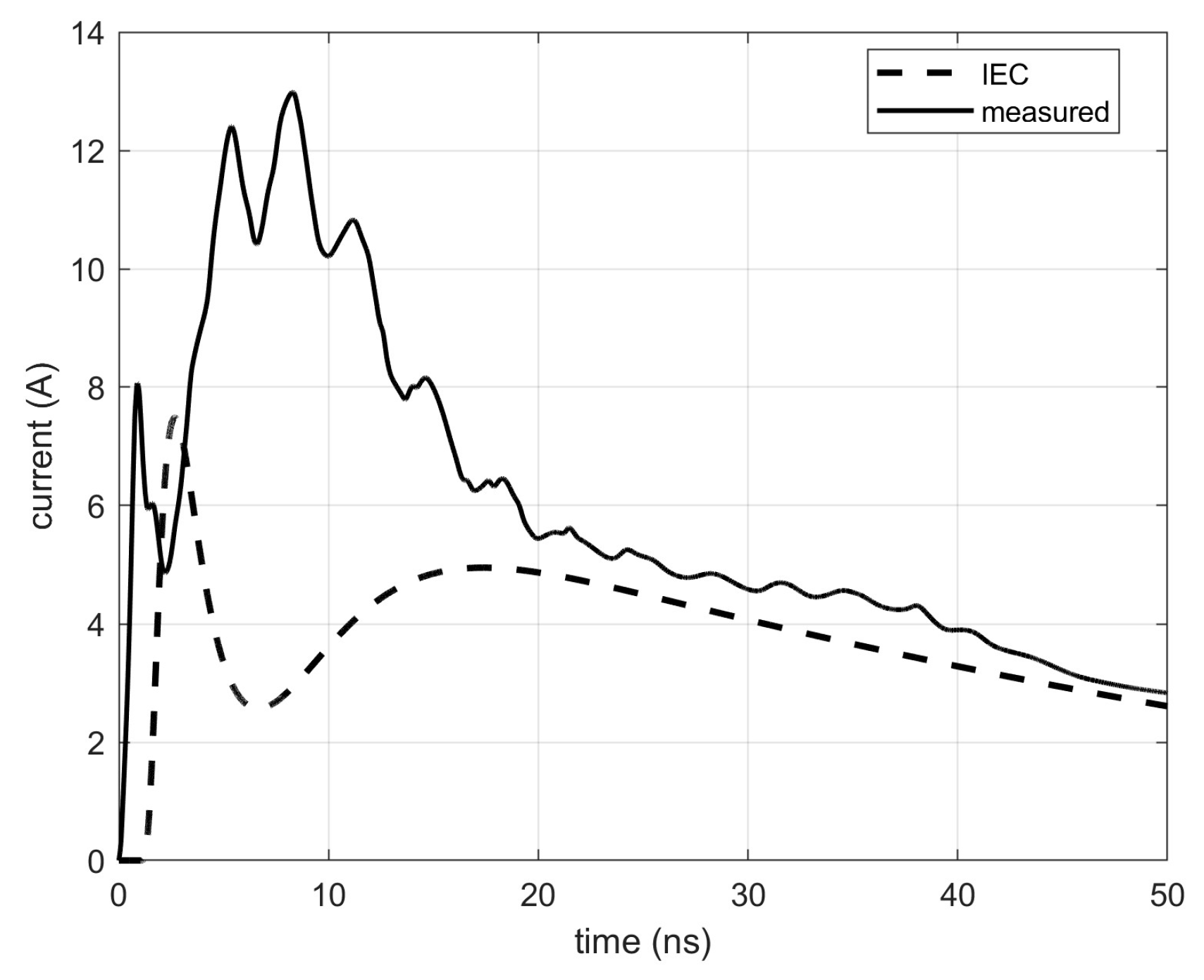
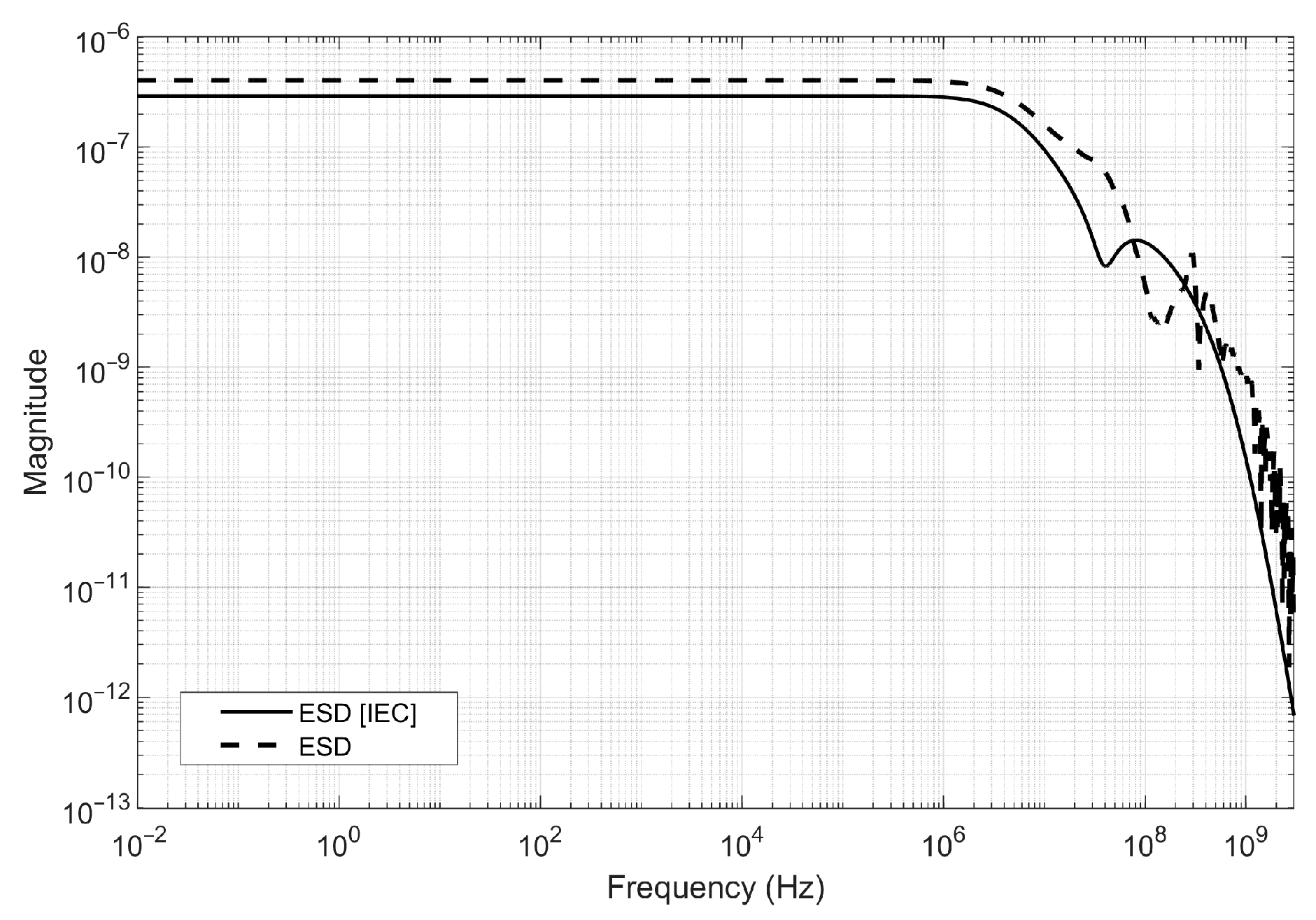
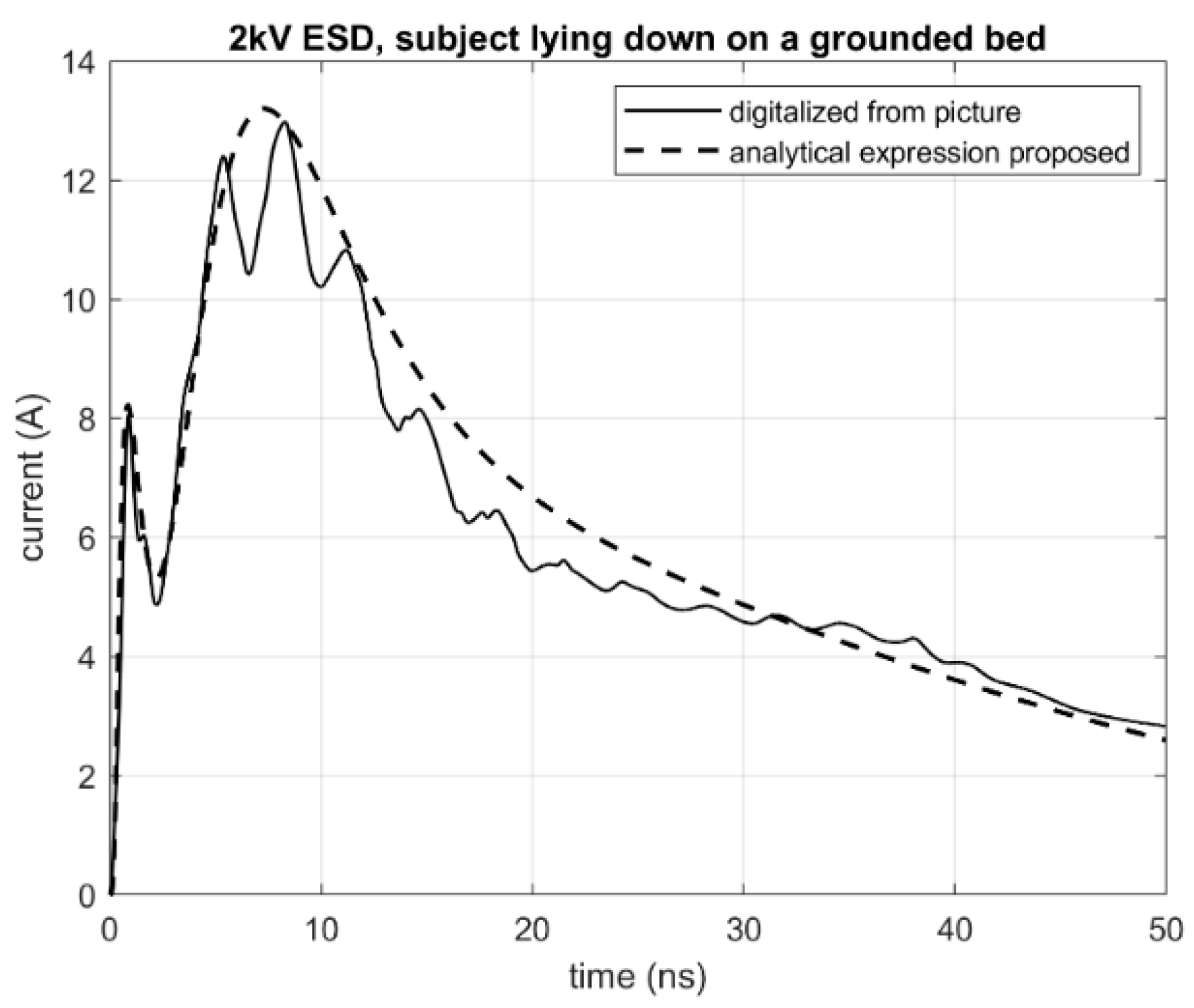

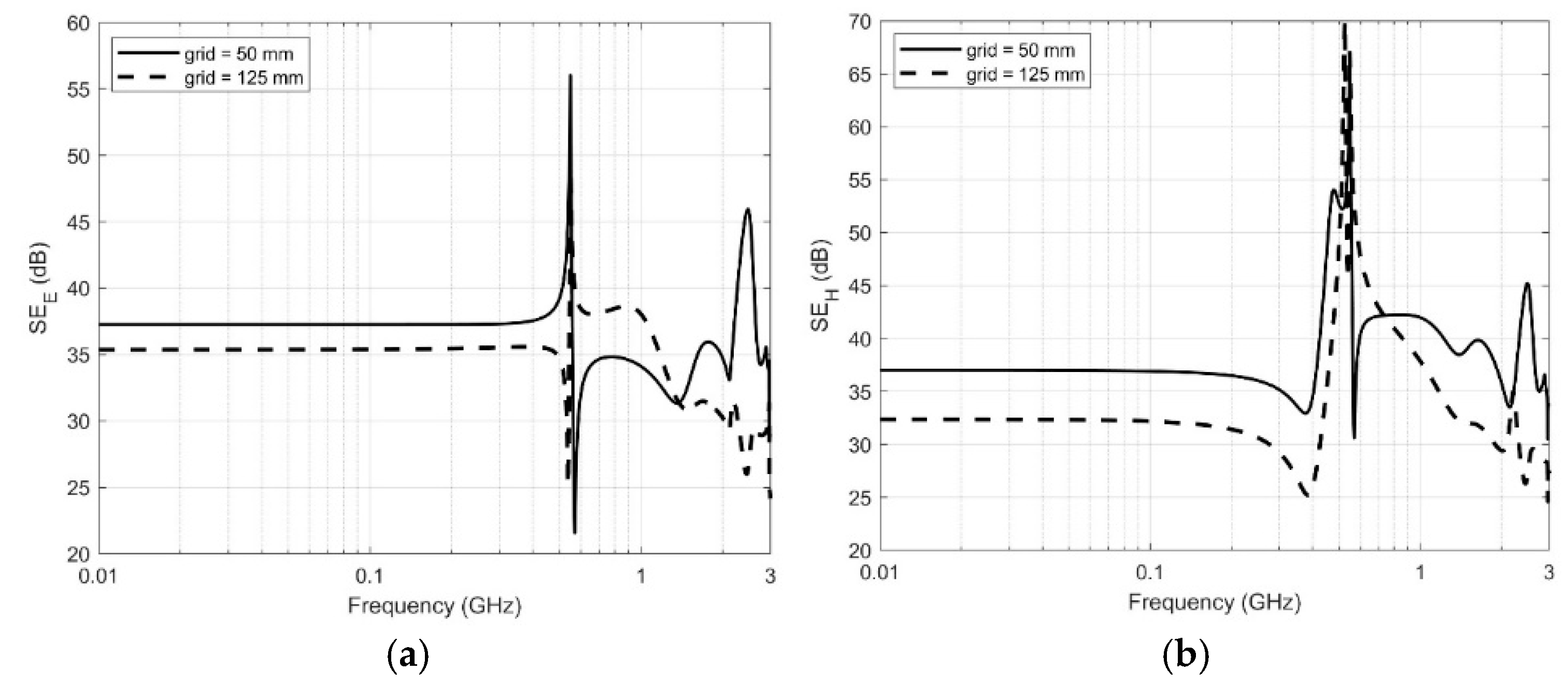
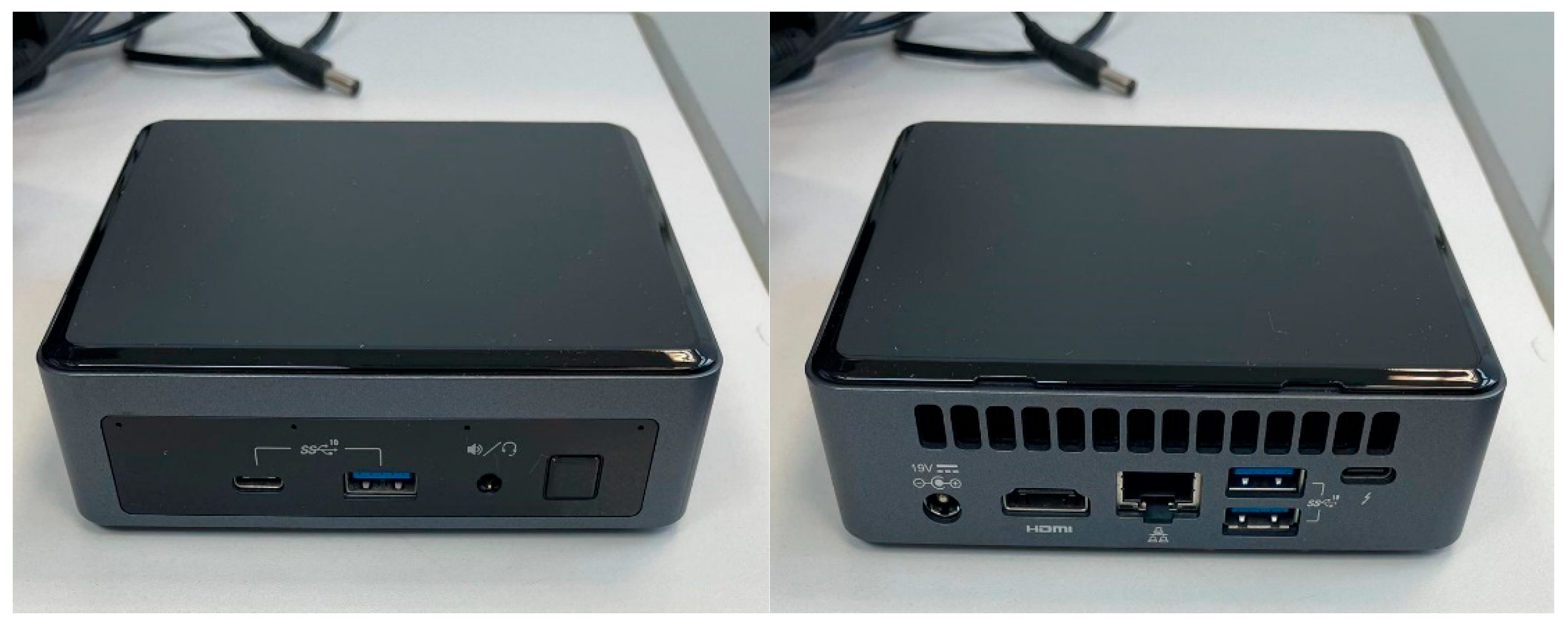

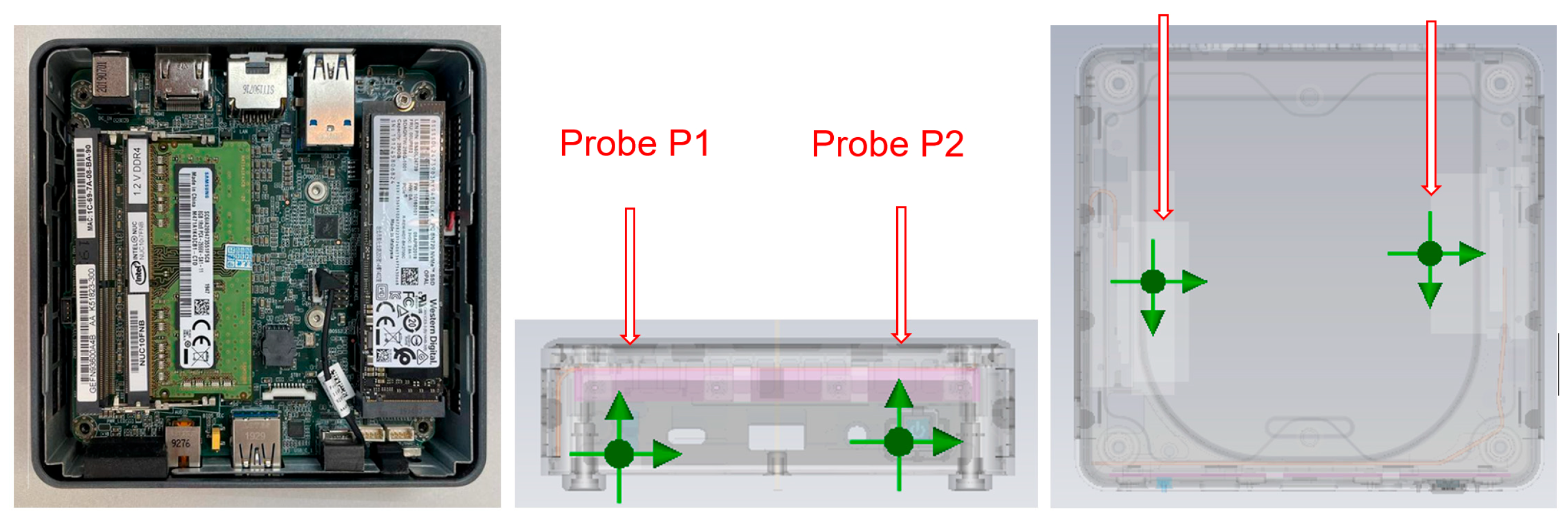
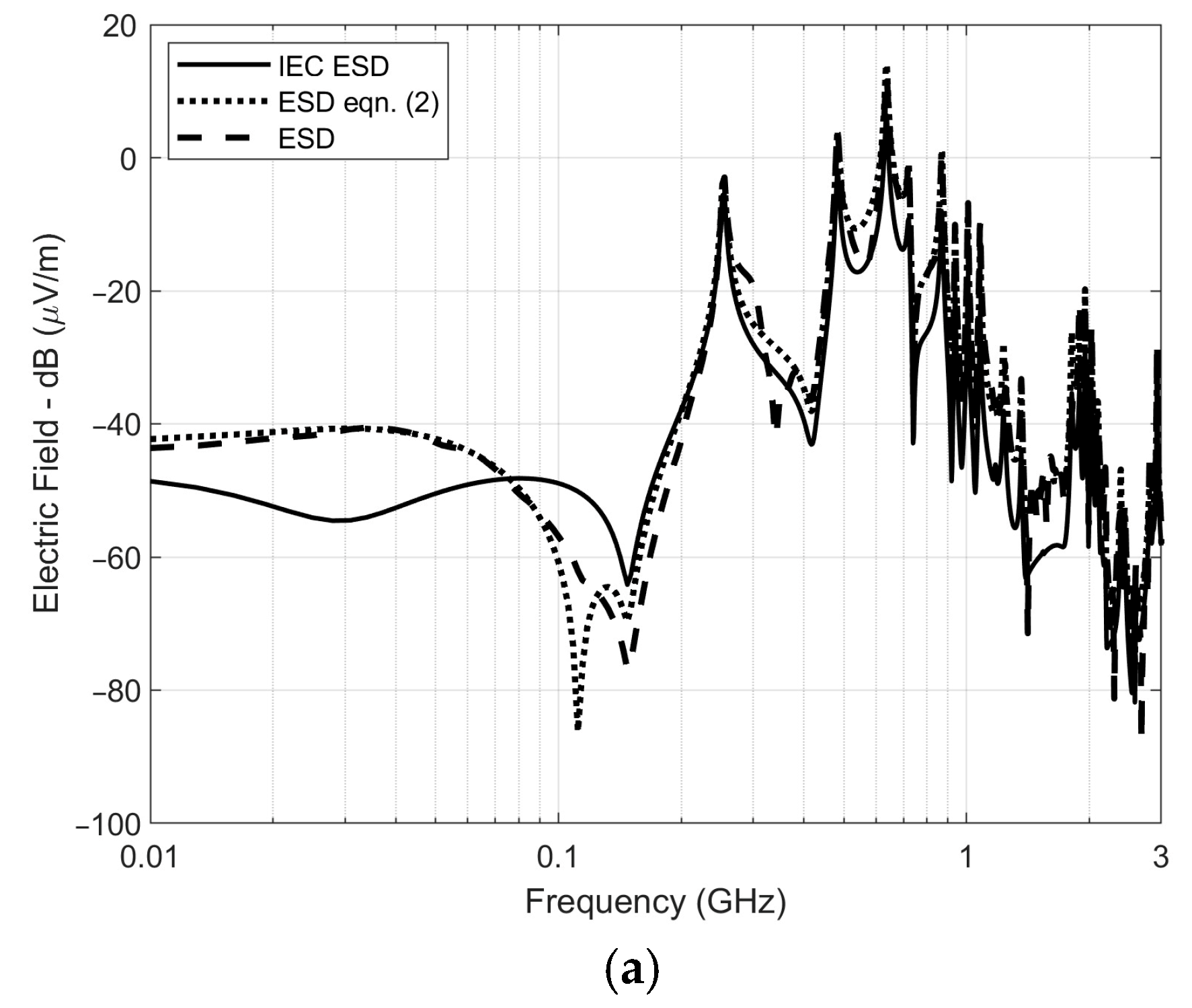
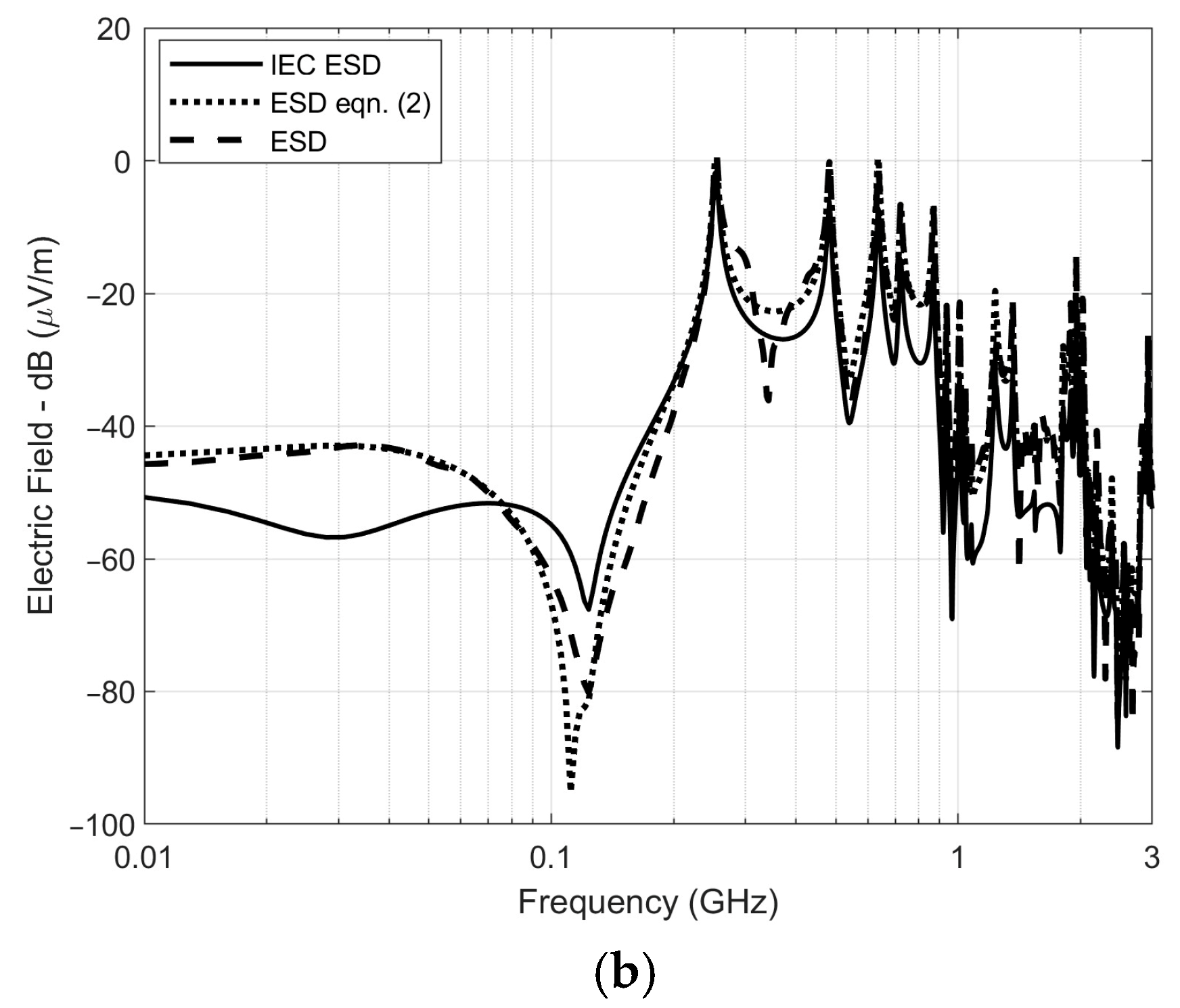
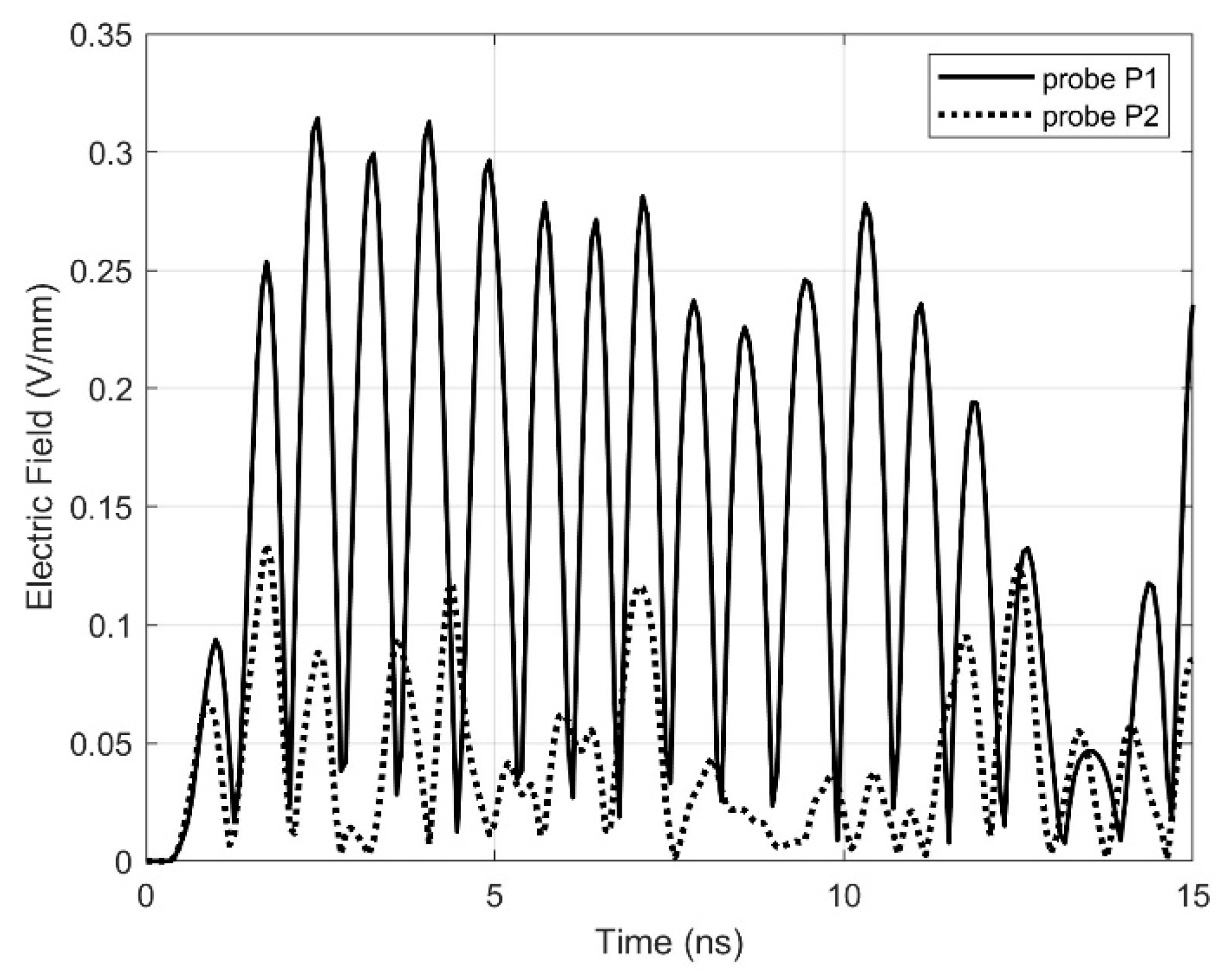


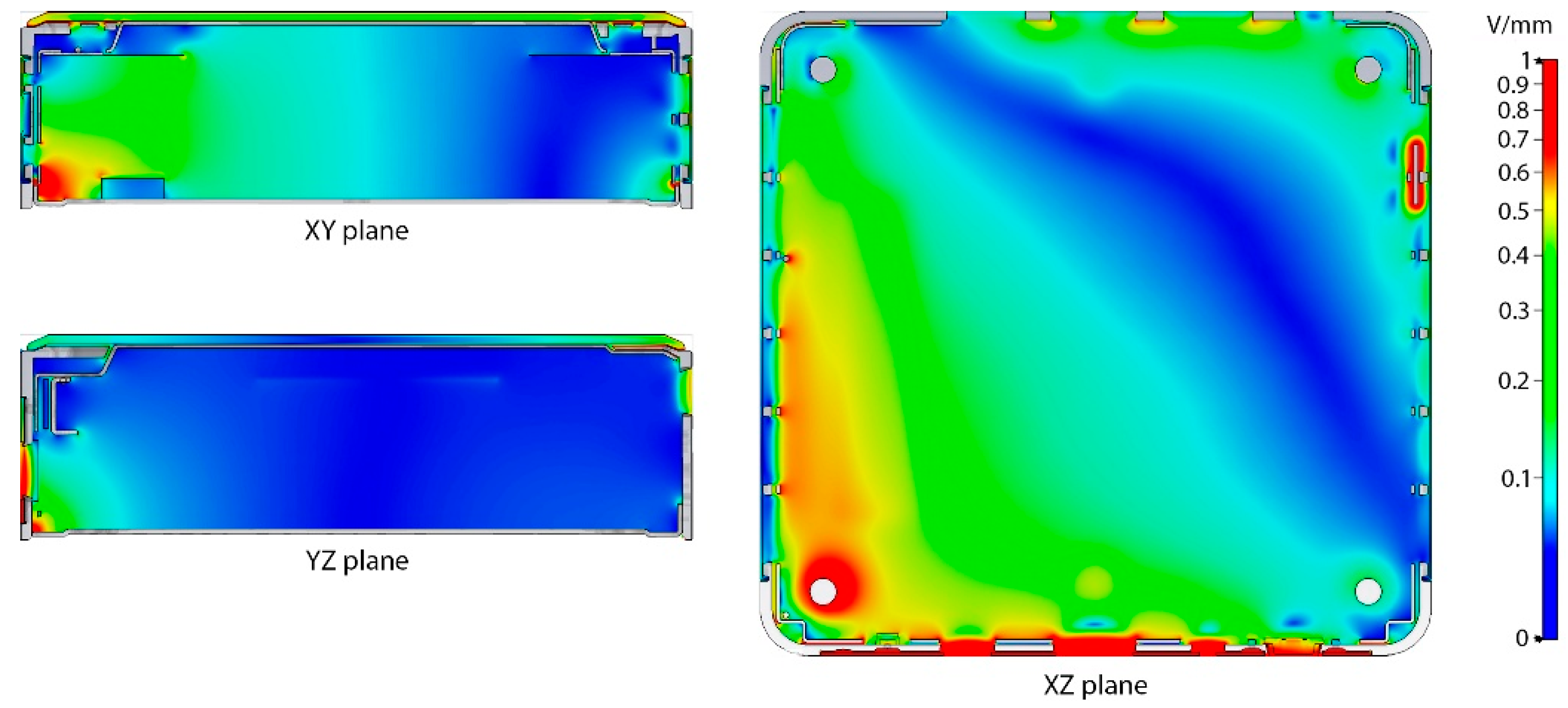
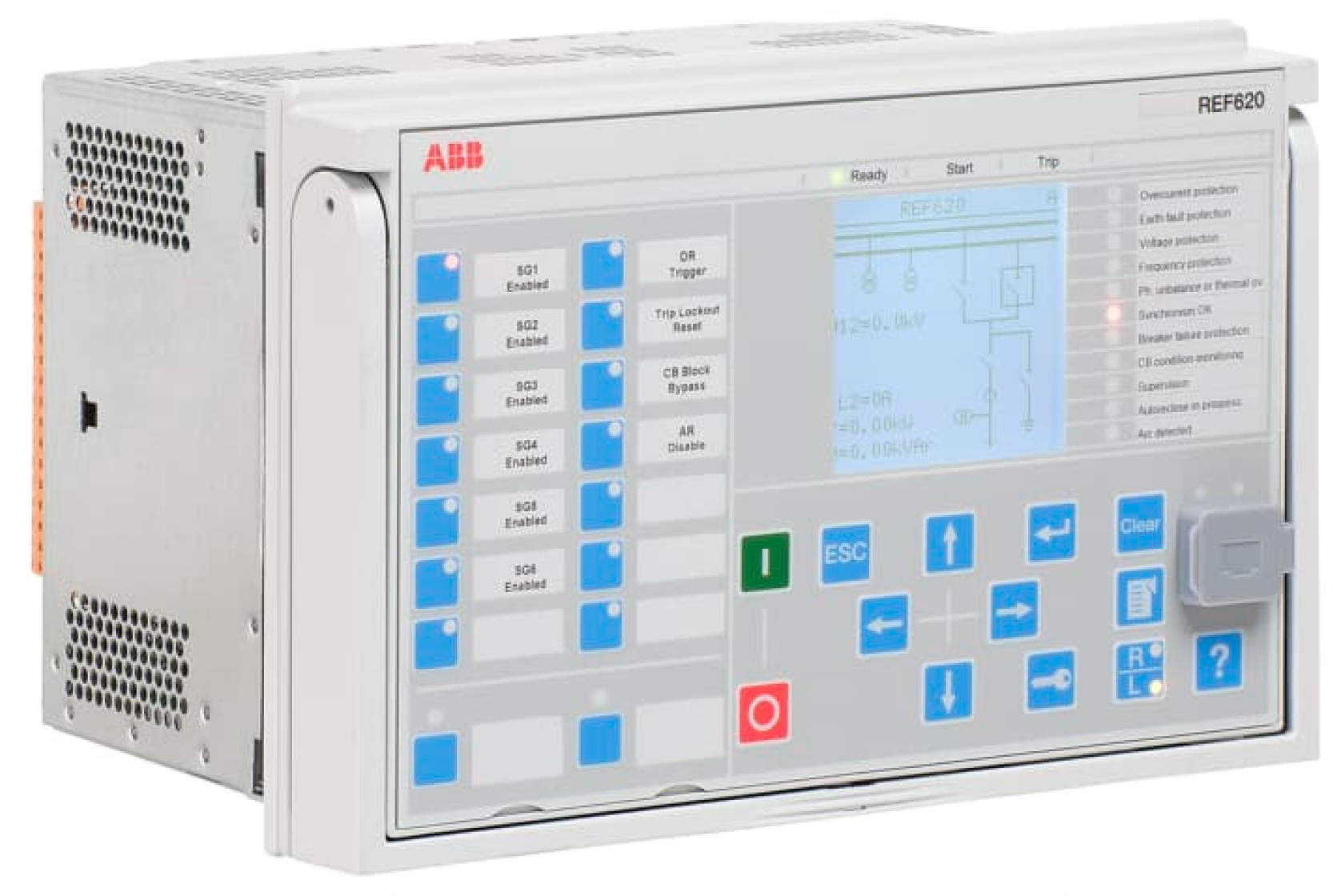

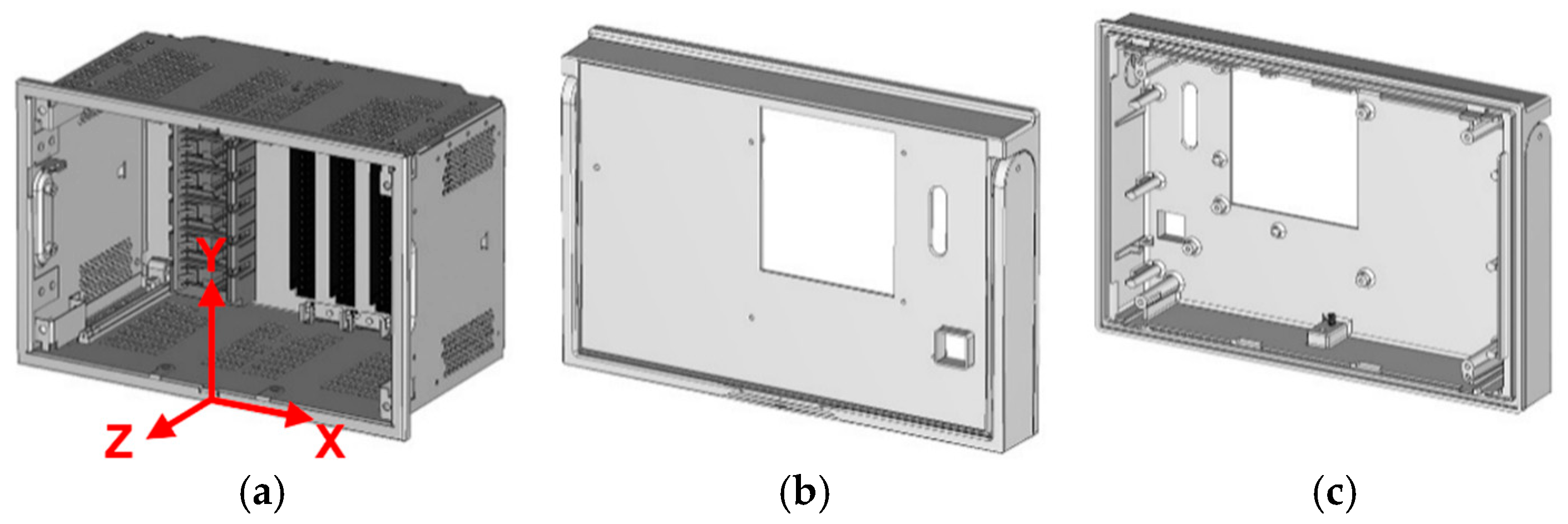
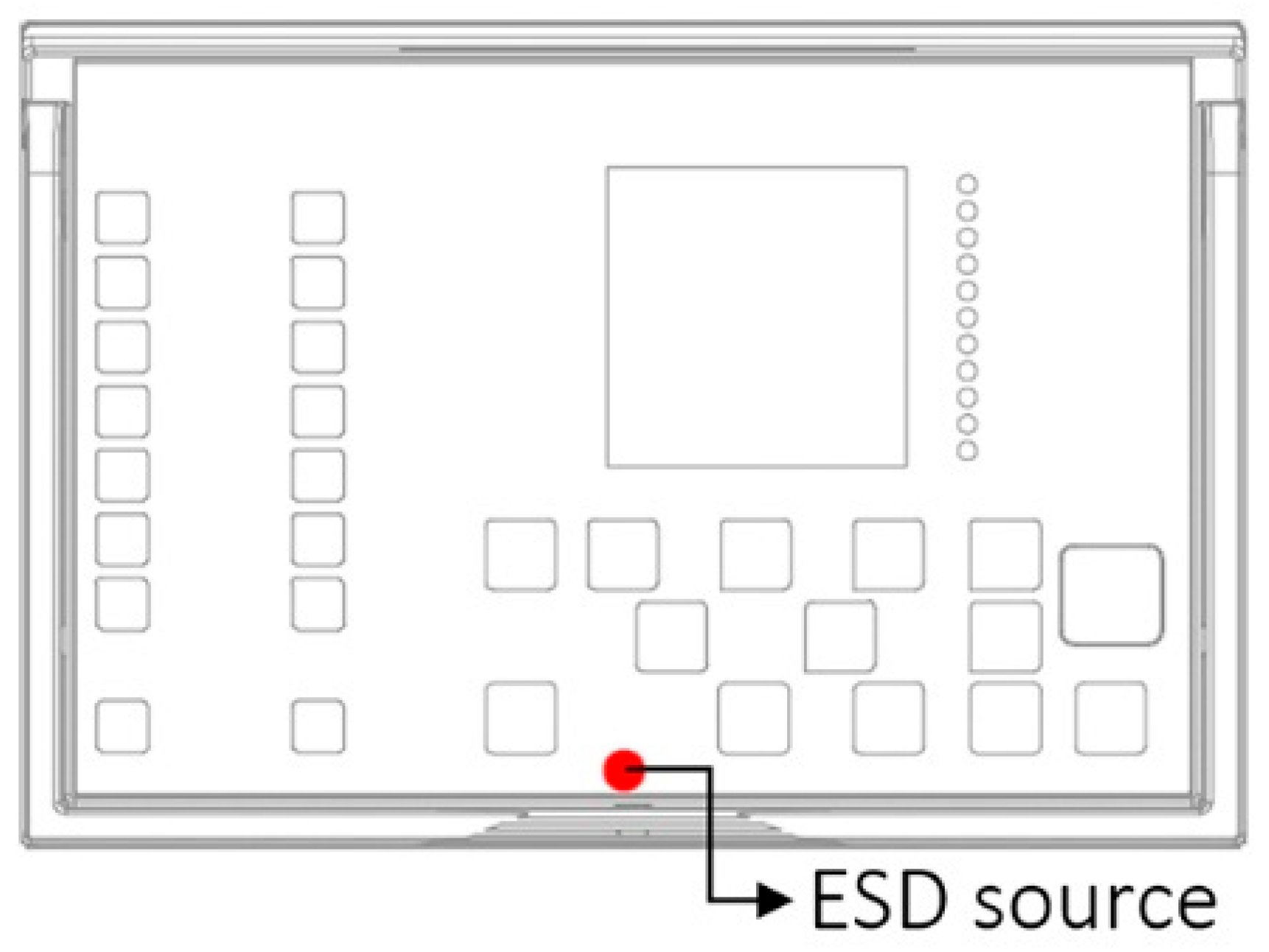
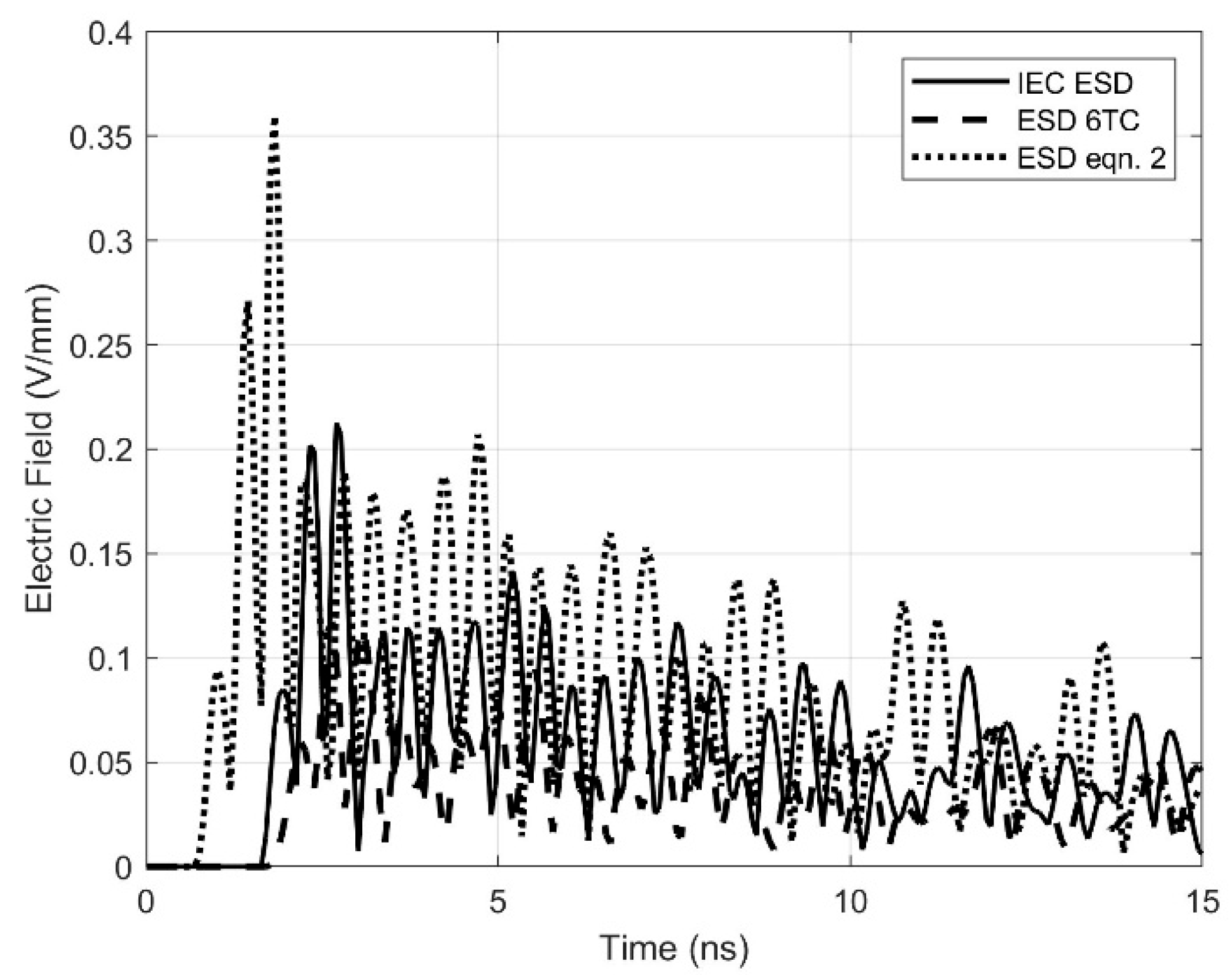
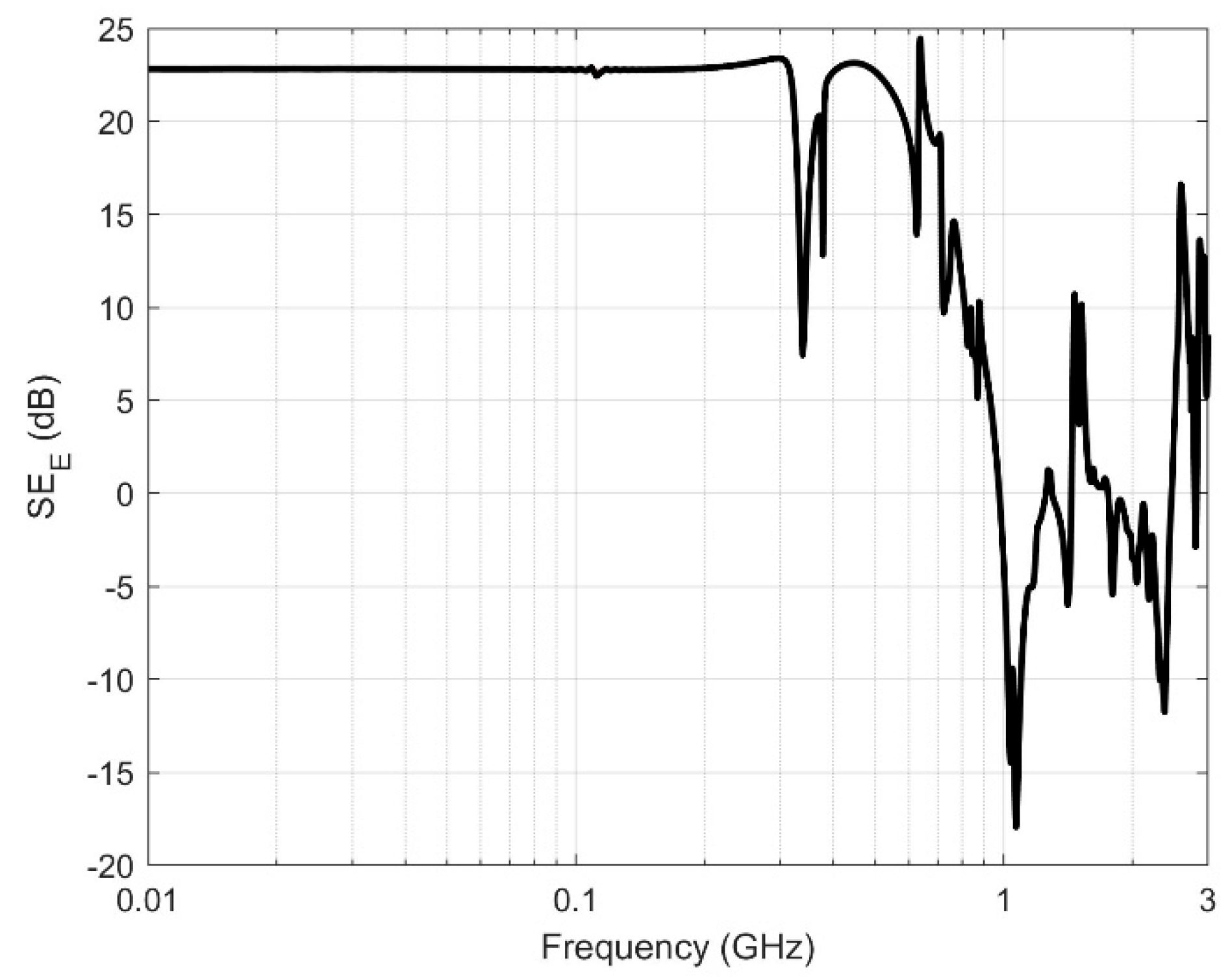
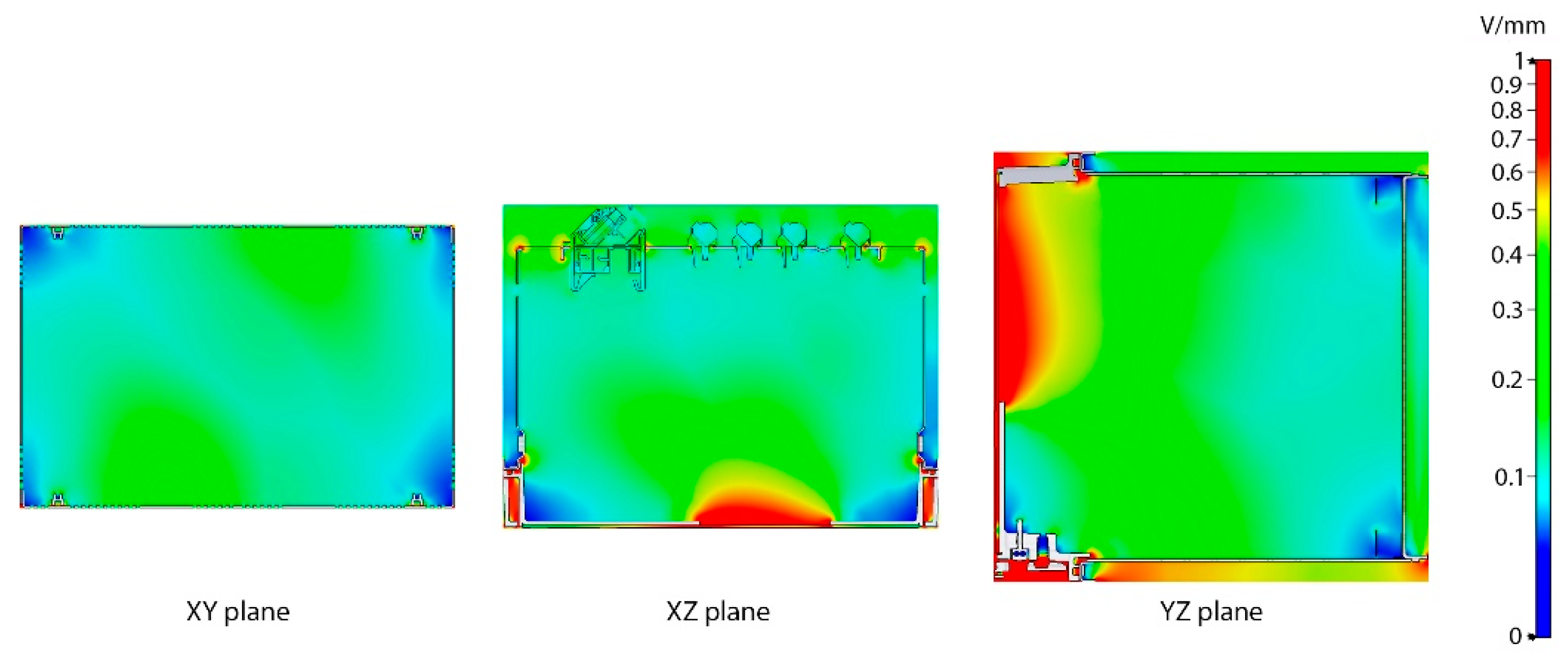
| Contact Discharge | Air Discharge | ||
|---|---|---|---|
| Level | Test Voltage (kV) | Level | Test Voltage (kV) |
| 1 | 2 | 1 | 2 |
| 2 | 4 | 2 | 4 |
| 3 | 6 | 3 | 8 |
| 4 | 8 | 4 | 15 |
| Applied Voltage (kV) | Peak Current (A) |
|---|---|
| 2 | 7.5 |
| 4 | 15 |
| 6 | 22.5 |
| 8 | 30 |
| 10 | 37.5 |
| I0 = 21.00 A | τ1 = 0.27 ns | τ2 = 1.17 ns | p = 5 |
| I1 = 51.60 A | τ3 = 2.67 ns | τ4 = 6.47 ns | q = 5 |
| I2 = 17.40 A | τ5 = 12.13 ns | τ6 = 26.84 ns | r = 3 |
Disclaimer/Publisher’s Note: The statements, opinions and data contained in all publications are solely those of the individual author(s) and contributor(s) and not of MDPI and/or the editor(s). MDPI and/or the editor(s) disclaim responsibility for any injury to people or property resulting from any ideas, methods, instructions or products referred to in the content. |
© 2025 by the authors. Licensee MDPI, Basel, Switzerland. This article is an open access article distributed under the terms and conditions of the Creative Commons Attribution (CC BY) license (https://creativecommons.org/licenses/by/4.0/).
Share and Cite
Attolini, G.; Celozzi, S.; Stracqualursi, E. Indirect Electrostatic Discharge (ESD) Effects on Shielded Components Installed in MV/LV Substations. Energies 2025, 18, 1056. https://doi.org/10.3390/en18051056
Attolini G, Celozzi S, Stracqualursi E. Indirect Electrostatic Discharge (ESD) Effects on Shielded Components Installed in MV/LV Substations. Energies. 2025; 18(5):1056. https://doi.org/10.3390/en18051056
Chicago/Turabian StyleAttolini, Giuseppe, Salvatore Celozzi, and Erika Stracqualursi. 2025. "Indirect Electrostatic Discharge (ESD) Effects on Shielded Components Installed in MV/LV Substations" Energies 18, no. 5: 1056. https://doi.org/10.3390/en18051056
APA StyleAttolini, G., Celozzi, S., & Stracqualursi, E. (2025). Indirect Electrostatic Discharge (ESD) Effects on Shielded Components Installed in MV/LV Substations. Energies, 18(5), 1056. https://doi.org/10.3390/en18051056







